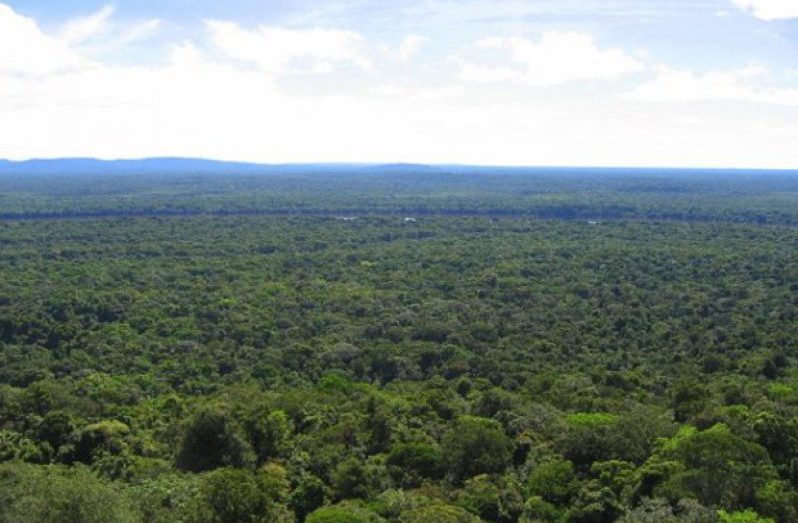–potential arrangement could earn nation millions of USD
THE Government of Guyana has signed a letter of intent with U.S.-based non-profit organisation (NGO), Emergent Finance Accelerated Inc. to market Guyana’s carbon credit, globally.
A carbon credit is a tradable permit or certificate that allows the holder of the credit the right to emit a tonne of carbon dioxide or an equivalent of another greenhouse gas.
Guyana is considered a carbon sink, which is any reservoir, natural or otherwise, that absorbs more carbon than it releases, and thereby lowers the concentration of (Carbon dioxide) CO 2 from the atmosphere. Should the agreement with the NGO be operationalised, Guyana stands a chance of earning hundreds of millions of United States Dollars annually, President, Dr. Irfaan Ali, has said. The Head of State, during a press conference on Wednesday, explained that the NGO will be looking for markets for Guyana’s carbon credit.
He said there is a base price of US$10 per unit and even if the company is able to secure a higher price for the unit, all the revenue will come to the country, excluding the operational costs.
“We have just entered into this letter of intent with the company so they are now going to go and look for the market. That is ongoing,” President Ali said.
Already, Guyana has received funds from Norway for the preservation of its forests and limiting of carbon emissions.
In signing a Memorandum of Understanding (MoU) with the Government of Guyana on November 9, 2009, the Government of Norway had committed to providing financial support of up to U.S.$250 million for results achieved by Guyana in limiting emissions from deforestation and forest degradation.
As part of the agreement, the two countries had agreed to establish the Guyana REDD+ Investment Fund (GRIF) as the financial intermediary mechanism for the performance-based payments from contributors to Guyana. The GRIF represented an effort to create an innovative climate finance mechanism which balances national sovereignty over investment priorities, while ensuring that REDD+ funds adhere to the partner entities’ financial, environmental and social safeguards.
Although the initial agreement has ended, the government is engaging Norway on the possibility of a new arrangement.
”Discussions on a new agreement are well underway, but we have not gone out of the discussion stages yet, but they are fairly advanced,” President Ali said.
There are, however, remaining resources from the last agreement, which are being programmed now into the renewable energy sector.
“Guyana is a carbon sink and we have to leverage assets to bring money into this country to support economic development,” Vice-President, Bharrat Jagdeo had said in September, last year.
The Vice-President had said that this is what the past People’s Progressive Party/Civic (PPP/C) administration sought to do through the Low Carbon Development Strategy (LCDS).
In June 2009, the then Government of Guyana launched its LCDS, which aimed to transform Guyana’s economy on to a low-carbon, sustainable development trajectory, while simultaneously combating climate change. The LCDS was geared at protecting and maintaining the forests in an effort to reduce global carbon emissions and at the same time attract payments from developed countries for the climate services that the forests provide to the world.
This strategy was, however, cast aside by the former A Partnership for National Unity + Alliance For Change (APNU+AFC) administration, which released its “Green State Development Strategy (GSDS).”
“The green state strategy was a sham… they farmed it out to the international consultants, so it was not grounded in the Guyanese reality and could not solve our problems,” Vice-President Jagdeo was reported as saying. Considering the issues related to the GSDS, Vice-President reiterated the relevance of the LCDS, noting: “This strategy will be expanded to cover the sale of biodiversity services; biodiversity management; and management of water resources… those are important parts of where we want to expand the LCDS into new frontiers.”
Jagdeo promised that actual work will be done under the LCDS, unlike what obtained with the GSDS. No project was implemented under the GSDS other than the planting of trees, said the Vice-President. President Ali, on Wednesday, said discussions on the LCDS were recently reinforced at a Commonwealth Heads of Government Americas roundtable discussion, which was hosted by His Royal Highness Prince Charles. The roundtable discussed how to advance green recovery post COVID, and initiatives to be taken for consideration at the 26th United Nations (UN) Climate Change Conference of the Parties (COP26) later this year.



.jpg)










